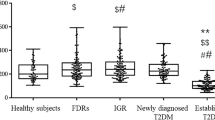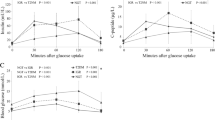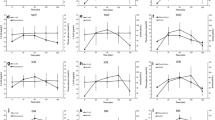Abstract
Background and aims
The aim of the present study was to assess soluble CD40 Ligand (sCD40L) levels in relation to impaired glucose tolerance (IGT) at population level.
Methods
This study is part of a prospective, population-based cohort study, carried out from 1990 to 2008 in northern Finland. Study members, born in 1935 and living in the City of Oulu, underwent oral glucose tolerance test (OGTT) and measurement of plasma sCD40L at three different time points during the 15-year follow-up. The total number of study members who underwent OGTT was 768 at the baseline, 557 at the first and 467 at the second follow-up. SCD40L levels in patients with IGT were compared with those in subjects with normal glucose tolerance or impaired fasting glucose (non-IGT).
Results
Geometric mean level of sCD40L was significantly higher in the IGT group compared with the non-IGT group at the baseline (0.42 vs. 0.27 ng/mL) and at the first follow-up (1.50 vs. 0.36 ng/mL) (repeated measures mixed models ANOVA, p < 0.05). At the second follow-up (age 72–73 years), however, the difference was not statistically significant (9.44 vs. 7.24 ng/mL). During the entire follow-up, the levels of sCD40L increased significantly both in IGT and non-IGT groups.
Conclusion
We found that plasma sCD40L level increases with age as well as there are elevated levels of plasma sCD40L in subjects with IGT compared with non-IGT. This may indicate an increased cardiovascular risk in older age and in subjects with IGT.

Similar content being viewed by others
References
Ceriello A (2004) Impaired glucose tolerance and cardiovascular disease: the possible role of post-prandial hyperglycemia. Am Heart J 147:803–807
Grundy SM (2012) Pre-diabetes, metabolic syndrome, and cardiovascular risk. J Am Coll Cardiol 59:635–643
DeFronzo RA, Abdul-Ghani M (2011) Assessment and treatment of cardiovascular risk in prediabetes: impaired glucose tolerance and impaired fasting glucose. Am J Cardiol 108:3B–24B
Pamukcu B, Lip GY, Snezhitskiy V et al (2011) The CD40-CD40L system in cardiovascular disease. Ann Med 43:331–340
Coban E, Kucuktag S, Basyigit S (2007) Platelet activation in subjects with impaired glucose tolerance. Platelets 18:591–594
Antoniades C, Bakogiannis C, Tousoulis D et al (2009) The CD40/CD40 ligand system: linking inflammation with atherothrombosis. J Am Coll Cardiol 54:669–677
Henn V, Slupsky JR, Grafe M et al (1998) CD40 ligand on activated platelets triggers an inflammatory reaction of endothelial cells. Nature 391:591–594
Neubauer H, Setiadi P, Gunesdogan B et al (2010) Influence of glycaemic control on platelet bound CD40-CD40L system, P-selectin and soluble CD40 ligand in type 2 diabetes. Diabet Med 27:384–390
Varo N, Vicent D, Libby P et al (2003) Elevated plasma levels of the atherogenic mediator soluble CD40 ligand in diabetic patients: a novel target of thiazolidinediones. Circulation 107:2664–2669
Harding SA, Sommerfield AJ, Sarma J et al (2004) Increased CD40 ligand and platelet-monocyte aggregates in patients with type 1 diabetes mellitus. Atherosclerosis 176:321–325
Jinchuan Y, Zonggui W, Jinming C et al (2004) Upregulation of CD40–CD40 ligand system in patients with diabetes mellitus. Clin Chim Acta 339:85–90
Lim HS, Blann AD, Lip GY (2004) Soluble CD40 ligand, soluble P-selectin, interleukin-6, and tissue factor in diabetes mellitus: relationships to cardiovascular disease and risk factor intervention. Circulation 109:2524–2528
Lee WL, Lee WJ, Chen YT et al (2006) The presence of metabolic syndrome is independently associated with elevated serum CD40 ligand and disease severity in patients with symptomatic coronary artery disease. Metabolism 55:1029–1034
Unek IT, Bayraktar F, Solmaz D et al (2010) Enhanced levels of soluble CD40 ligand and C-reactive protein in a total of 312 patients with metabolic syndrome. Metabolism 59:305–313
Dallmeier D, Larson MG, Vasan RS et al (2012) Metabolic syndrome and inflammatory biomarkers: a community-based cross-sectional study at the Framingham heart study. Diabetol Metab Syndr 4:28
Desideri G, Ferri C (2003) Effects of obesity and weight loss on soluble CD40L levels. JAMA 289:1781–1782
Gokulakrishnan K, Deepa R, Mohan V et al (2006) Soluble P-selectin and CD40L levels in subjects with prediabetes, diabetes mellitus, and metabolic syndrome—the Chennai urban rural epidemiology study. Metabolism 55:237–242
Singh T, Newman AB (2011) Inflammatory markers in population studies of aging. Ageing Res Rev 10:319–329
Rajala U, Keinanen-Kiukaanniemi S, Uusimaki A et al (1995) Prevalence of diabetes mellitus and impaired glucose tolerance in a middle-aged finnish population. Scand J Prim Health Care 13:222–228
Rajala U, Qiao Q, Laakso M et al (2000) Antihypertensive drugs as predictors of type 2 diabetes among subjects with impaired glucose tolerance. Diabetes Res Clin Pract 50:231–239
Alberti KG, Zimmet PZ (1998) Definition, diagnosis and classification of diabetes mellitus and its complications. Part 1: diagnosis and classification of diabetes mellitus provisional report of a WHO consultation. Diabet Med 15:539–553
World Health Organization (2006) Definition and diagnosis of diabetes mellitus and intermediate hyperglycemia: report of a WHO/IDF consultation. World Health Organization, Geneva
American Diabetes Association (2011) Diagnosis and classification of diabetes mellitus. Diabetes Care 34:S62–S69
Preciado-Puga MC, Malacera JM, Fajardo-Araujo ME et al (2014) Markers of the progression of complications in patients with type 2 diabetes: a 1-year longitudinal study. Exp Clin Endocrinol Diabetes 122:484–490
Lievens D, Zernecke A, Seijkens T et al (2010) Platelet CD40L mediates thrombotic and inflammatory processes in atherosclerosis. Blood 116:317–4327
Schonbeck U, Varo N, Libby P et al (2001) Soluble CD40L and cardiovascular risk in women. Circulation 104:2266–2268
Yan JC, Zhu J, Gao L et al (2004) The effect of elevated serum soluble CD40 ligand on the prognostic value in patients with acute coronary syndromes. Clin Chim Acta 343:155–159
Almdal T, Scharling H, Jensen JS et al (2004) The independent effect of type 2 diabetes mellitus on ischemic heart disease, stroke, and death: a population-based study of 13,000 men and women with 20 years of follow-up. Arch Intern Med 164:1422–1426
Yngen M, Ostenson CG, Hu H et al (2004) Enhanced P-selectin expression and increased soluble CD40 ligand in patients with type 1 diabetes mellitus and microangiopathy: evidence for platelet hyperactivity and chronic inflammation. Diabetologia 47:537–540
de Lemos JA, Zirlik A, Schonbeck U et al (2005) Associations between soluble CD40 ligand, atherosclerosis risk factors, and subclinical atherosclerosis: results from the Dallas heart study. Arterioscler Thromb Vasc Biol 25:2192–2196
Dallmeier D, Larson MG, Wang N et al (2012) Addition of inflammatory biomarkers did not improve diabetes prediction in the community: the Framingham heart study. J Am Heart Assoc 1:e000869
Seijkens T, Kusters P, Engel D et al (2013) CD40-CD40L: linking pancreatic, adipose tissue and vascular inflammation in type 2 diabetes and its complications. Diabet Vasc Dis Res 10:115–122
DECODE Study Group, The European Diabetes Epidemiology Group (2001) Glucose tolerance and cardiovascular mortality: comparison of fasting and 2-hour diagnostic criteria. Arch Intern Med 161:397–405
Keaney JF Jr, Lipinska I, Larson MG et al (2008) Clinical correlates, heritability, and genetic linkage of circulating CD40 ligand in the Framingham offspring study. Am Heart J 156:1003–1009
Acknowledgments
The authors would like to thank the whole study team for collaboration.
Author information
Authors and Affiliations
Corresponding author
Ethics declarations
Conflict of interest
None of the authors have any conflict of interest in connection with the submitted article.
Ethical approval
The study protocol was approved by the Ethics Committee of the Faculty of Medicine, University of Oulu, Oulu, Finland.
Informed consent
Informed consent was obtained from all individual participants included in the study.
Statement of human and animal rights
All procedures performed in studies involving human participants were in accordance with the ethical standards of the 1964 Helsinki declaration and its later amendments. No studies with animals were performed.
Funding
The work was done in the Center for Life Course Epidemiology, University of Oulu, Finland.
Rights and permissions
About this article
Cite this article
Linna, H., Suija, K., Rajala, U. et al. The association between impaired glucose tolerance and soluble CD40 ligand: a 15-year prospective cohort study. Aging Clin Exp Res 28, 1243–1249 (2016). https://doi.org/10.1007/s40520-015-0524-z
Received:
Accepted:
Published:
Issue Date:
DOI: https://doi.org/10.1007/s40520-015-0524-z




